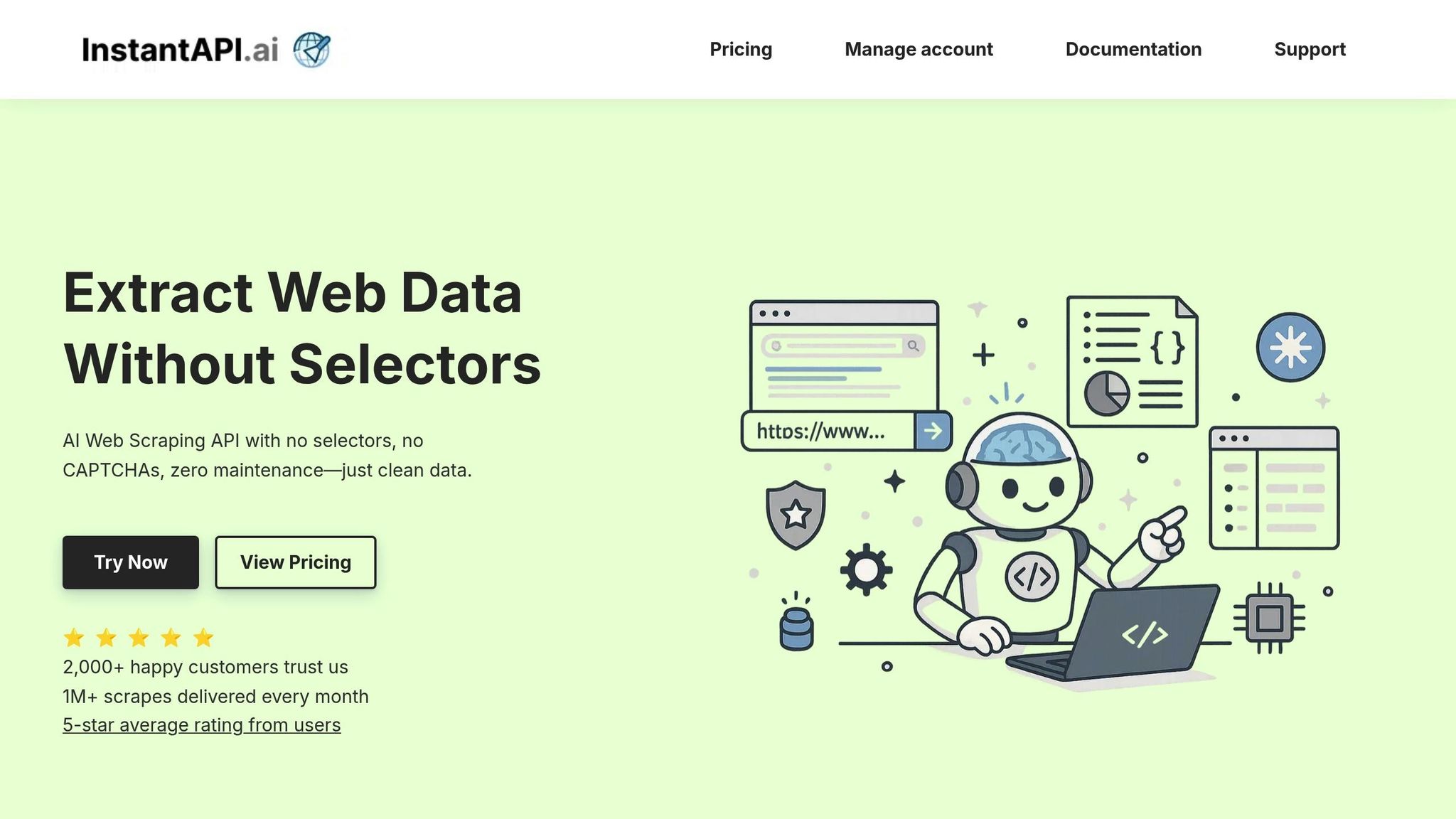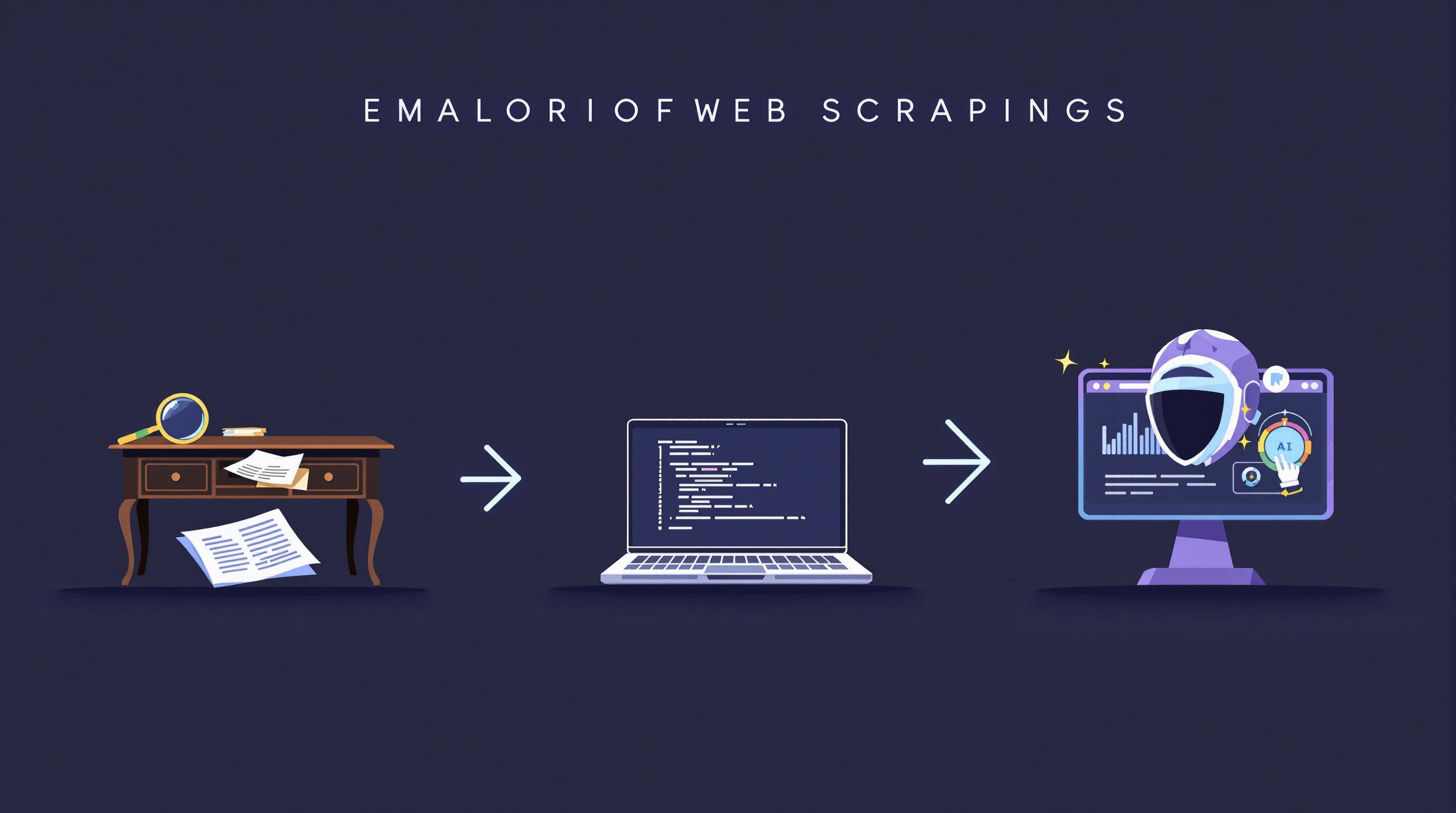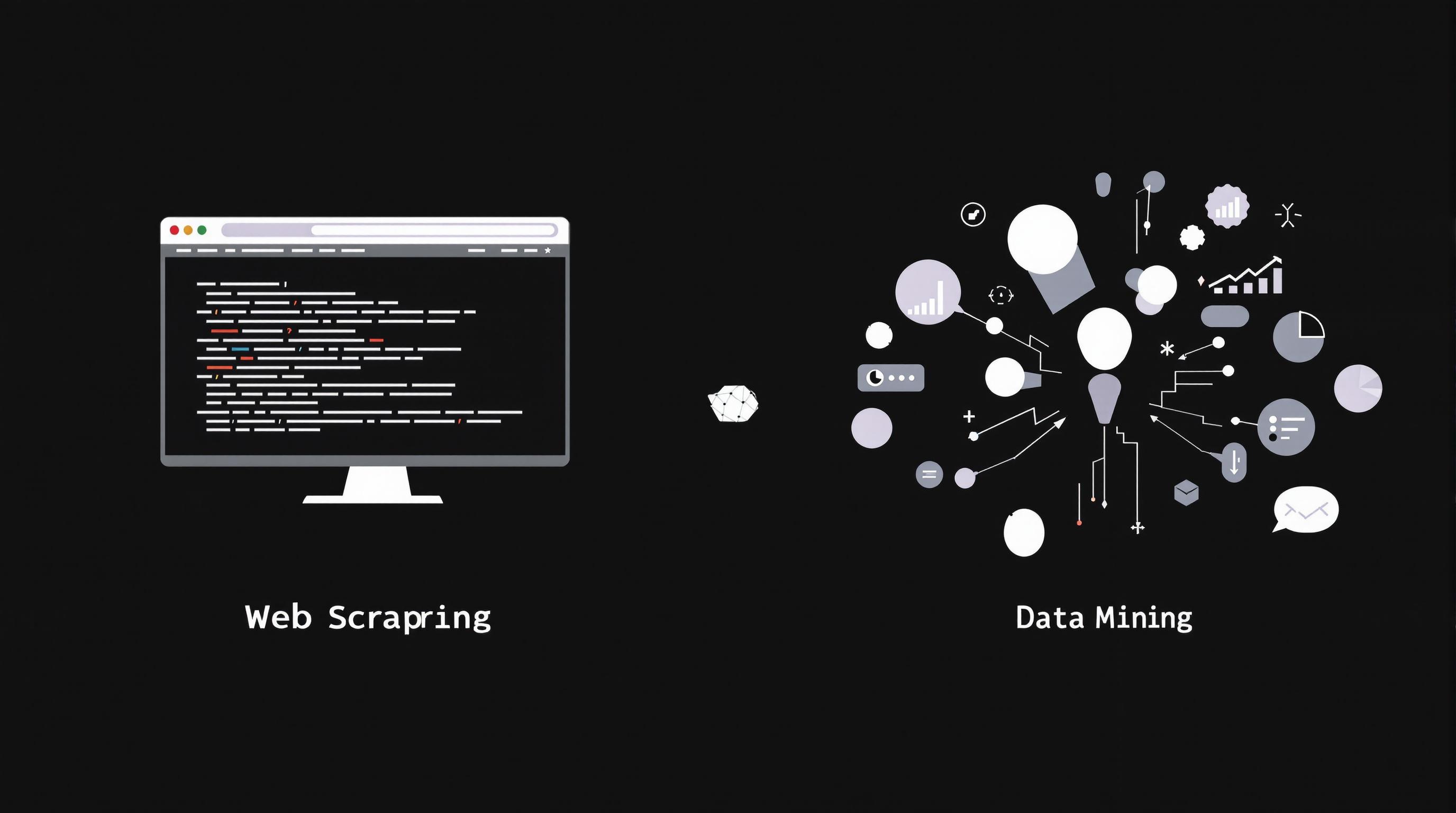Web scraping is a key tool for language translation services. It helps collect multilingual data from websites, forums, and news platforms, which is essential for improving translation models. Here's what you need to know:
- Why it matters: Translation models need diverse linguistic data to handle idioms, regional nuances, and underrepresented languages.
- Challenges: Issues like encoding errors, website updates, and CAPTCHA protections can disrupt data collection.
- Solutions: Tools like Python libraries (BeautifulSoup, Scrapy) or services like InstantAPI.ai simplify data extraction, even from dynamic or multilingual websites.
- Cost: InstantAPI.ai offers a pay-as-you-go model at $2 per 1,000 pages, reducing maintenance and setup time.
Efficient multilingual scraping ensures translation models are trained on accurate, diverse datasets, improving performance across languages.
Python Project | Web SCRAPE NEWS Articles | Translate | Sentiment
Tools and Technologies for Multilingual Web Scraping
When it comes to collecting data in multiple languages, selecting the right tools can make all the difference. Python libraries are particularly useful for tackling the challenges of multilingual web scraping, offering flexibility for handling diverse languages and complex website structures.
Python Libraries for Data Extraction
BeautifulSoup is a go-to option for parsing HTML in Python. Its ease of use and readability make it a favorite among beginners working on straightforward scraping tasks. Paired with the Requests library, BeautifulSoup shines at extracting static HTML content from well-structured pages.
For multilingual projects, BeautifulSoup can be a handy tool for identifying languages. You can extract the lang attribute from HTML tags or analyze the body text for language detection. Here's a quick example:
from bs4 import BeautifulSoup
from langdetect import detect
with open("foo.html", "rb") as f:
soup = BeautifulSoup(f, "lxml")
[s.decompose() for s in soup("script")] # Remove <script> elements
body_text = soup.body.get_text()
print(detect(body_text))
However, BeautifulSoup has its limitations. It struggles with dynamic websites that rely on JavaScript for loading content, such as those using infinite scrolling.
Scrapy, on the other hand, is a powerful framework built for large-scale scraping tasks. It’s particularly effective for multilingual projects that involve crawling thousands of pages across different language versions. Companies like Intoli use Scrapy for lead generation and competitor analysis, while Lambert Labs combines it with Selenium to handle JavaScript-heavy sites.
For websites with JavaScript-rendered content, tools like Selenium or Playwright are better suited. Both can handle dynamic elements and are highly effective for multilingual scraping.
LXML is another option for parsing HTML, offering faster performance compared to BeautifulSoup. While it sacrifices some accessibility, its speed is a major advantage when processing millions of pages in different languages.
The newer HTTPX library is also worth mentioning. Supporting both synchronous and asynchronous APIs, as well as HTTP/2, it mimics browser-like requests, reducing the chances of being flagged by anti-bot systems.
While these tools provide a strong foundation for multilingual scraping, they require significant manual setup and ongoing maintenance - especially for websites that frequently change their structure.
InstantAPI.ai: Simplified Multilingual Web Scraping

For those looking to bypass the complexities of manual scraping, InstantAPI.ai offers a streamlined solution. Traditional libraries demand a lot of effort to set up and maintain, particularly for multilingual sites with dynamic content. InstantAPI.ai simplifies the entire process with API-based scraping.
Instead of writing CSS selectors or XPath expressions that might break when websites update, you just provide a URL and receive structured JSON in return. This is especially helpful for multilingual projects where you need to extract similar data from websites in various languages and regions.
InstantAPI.ai takes care of common scraping challenges like proxy rotation, CAPTCHA handling, and dynamic rendering. It’s designed to solve issues related to anti-bot systems and complex website structures.
The service operates on a pay-per-use model at $2 per 1,000 pages, making it cost-effective for projects with fluctuating workloads. Its API endpoints simplify tasks like:
- /scrape: Extracts multilingual content with field-level validations to ensure the data meets your formatting needs.
- /links: Identifies product pages or article sections using plain-English descriptions.
- /next: Automatically discovers pagination URLs across different language versions of a site.
This approach drastically reduces the time and effort required for multilingual data collection. What might have taken weeks of development can now be completed in a single day, keeping projects on track without the headache of constant scraper maintenance.
Methods for Extracting Multilingual Data
Extracting multilingual data isn't just about scraping text off a webpage; it's about using the right strategies to gather accurate, diverse datasets that reflect various languages, writing systems, and cultural nuances. The methods you choose will directly impact the quality and usability of your data. Below, we dive into practical techniques for parsing, detecting, and extracting multilingual content effectively.
HTML Parsing and DOM Navigation
HTML parsing is the cornerstone of multilingual data extraction. By breaking down HTML into a structured tree, you can systematically navigate and extract content in multiple languages. XPath expressions, in particular, offer a powerful way to traverse these HTML trees. Unlike CSS selectors, XPath can navigate in all directions and even transform results before returning them, making it especially useful for multilingual projects.
When crafting XPath expressions, focus on stable relationships rather than rigid structures. Websites often change their layouts, but the contextual relationships between elements tend to stay consistent. For example, you can use semantic markers instead of relying on element classes that may vary across languages.
from parsel import Selector
html = """<html>
<head>
<title>Page Title</title>
</head>
<body>
<h1 class="title">Page header by <a href="#">company</a></h1>
<p>This is the first paragraph</p>
<p>This is the second paragraph</p>
</body>
</html>"""
sel = Selector(html)
sel.xpath("//p").getall()
To make your XPath expressions more robust, use constraints like the contains() function. This approach ensures reliable extraction even when dealing with multilingual websites that present the same information in different languages but with varied HTML layouts.
DOM navigation becomes even more critical when working with languages that use non-standard reading directions or text orientations. For instance, Arabic and Hebrew are read right-to-left, while some East Asian languages might use vertical text layouts. To extract content accurately, your parsing logic must account for these variations, ensuring the data maintains its correct order and context.
Automated Language Detection and Content Filtering
Identifying the correct language is essential when building datasets for translation. A website's declared language doesn't always match its actual content, especially on platforms with user-generated content or sections in multiple languages.
"Efficiently scraping data from multilingual websites demands a nuanced approach, with a pivotal consideration being the accurate identification of the language embedded in the content. NLP techniques, such as language detection libraries like Langid.py or the use of pre-trained models like FastText, prove indispensable in discerning linguistic nuances." – Paresh Patil, LinkedIn Top Data Science Voice
Integrating language detection libraries into your scraping process allows you to dynamically identify and filter content by language. Tools like FastText, which can recognize over 170 languages, are particularly useful for large-scale multilingual projects. This ensures that only relevant data feeds into your translation models.
To avoid data corruption, always ensure proper UTF-8 encoding, especially when dealing with non-Latin scripts.
Content filtering goes beyond language detection. Different types of multilingual content - formal documents, conversational text, technical jargon, or cultural references - require unique handling. Using language-specific pre-processing techniques can help normalize text while preserving key linguistic features essential for translation models to learn from.
Additionally, cultural variations like date formats, number styles, and regional idioms add complexity to multilingual datasets. Your filtering logic should account for these differences to create datasets that reflect how languages are used in specific regions.
Handling Dynamic Content and Real-Time Data Extraction
Many modern websites rely on JavaScript to load dynamic content, which can complicate multilingual data extraction. Features like infinite scroll, AJAX-loaded translations, and real-time updates require specialized techniques beyond standard HTML parsing.
Dynamic content often loads based on user interactions or changes in the viewport. To capture such content, your scraper must simulate user behavior, such as scrolling or selecting language preferences. In some cases, content may vary based on browser language settings or geographic location, adding another layer of complexity.
Real-time data extraction becomes particularly important for platforms like news sites, social media, or e-commerce websites that frequently update their multilingual content. To avoid missing valuable data, your pipeline must efficiently track updates while capturing linguistic variations or new content that could enhance your translation models.
AJAX elements, which load asynchronously, may not appear during the initial parsing process. Implementing waiting strategies and verifying content are crucial to ensure you're collecting complete datasets rather than partial page loads.
Instead of handling browser automation or timing issues manually, consider services that can manage these complexities for you. Tools with automatic adaptation features are especially helpful for multilingual projects, as they can adjust to changes in a website's language-switching mechanisms or content-loading patterns. This ensures consistency in your data collection, even as websites evolve.
Solving Web Scraping Problems in Translation Workflows
Scraping data from multilingual websites comes with its own set of challenges, often derailing translation data collection efforts. From proxy blocks to changes in site structures, these hurdles can make maintaining a steady data flow incredibly difficult. Overcoming these obstacles is key to ensuring translation workflows remain smooth and efficient.
Handling Proxy, CAPTCHA, and Rate-Limiting Issues
One of the biggest barriers in multilingual web scraping is dealing with websites' security measures. IP blocks, CAPTCHAs, and rate limits can completely stop data collection, especially when scraping across multiple languages and regions. These measures are designed to combat bots but often complicate the scraping process.
Traditional approaches involve juggling multiple tactics - rotating proxies, adding random delays, switching User-Agent headers, and managing session persistence. This complexity multiplies when scraping multilingual sites, as each language version may have its own request limits or CAPTCHA challenges. For translation workflows, these disruptions can lead to inconsistent data, ultimately affecting the quality of translation models.
"Scraping isn't just about writing a script - it's about doing it the right way so your scraper runs smoothly and consistently."
– Ize Majebi, Python developer and data enthusiast
An example from April 2025 highlights the impact of automation: a market research firm used an API service to scrape competitor pricing data from 50 multilingual e-commerce sites. The result? They cut data collection time by 60% and improved accuracy by 35%, thanks to automated proxy and CAPTCHA handling.
InstantAPI.ai simplifies this process by bundling proxy rotation, CAPTCHA-solving, JavaScript rendering, and data extraction into a single API call. At just $2 per 1,000 pages, it eliminates the need to coordinate multiple tools, offering predictable costs for translation projects while handling all defensive measures automatically.
Next, let’s tackle another common challenge: adapting to site structure changes.
Adapting to Site Structure Changes
Frequent website redesigns can break scrapers, especially when dealing with multilingual sites. Different language versions might update at different times or even follow entirely different layouts. This inconsistency can wreak havoc on multilingual datasets, where structural uniformity is critical.
"Employing stable and specific selectors (such as CSS selectors or XPath) to target elements on the webpage can help mitigate the impact of minor structural changes. However, relying solely on selectors might not be sufficient if the website structure undergoes significant alterations."
– Kushagra Rastogi, Data Analyst
Traditional strategies to address this include using consistent ID attributes, heading tags, or custom data attributes when creating selectors. Some engineers also compare stripped-down versions of HTML files to detect changes. However, multilingual sites often add another layer of complexity. For instance, an English news site might use <article> tags, while the Arabic version employs <div class="content"> to accommodate right-to-left text.
InstantAPI.ai eliminates the need for constant selector updates. Instead of manually writing CSS selectors or XPath expressions, users simply define the required data in a JSON schema. This approach ensures consistent data extraction across multiple languages, even when site structures evolve.
Here’s how common solutions compare when it comes to multilingual scraping challenges:
Comparison of Multilingual Scraping Solutions
The table below highlights how different approaches stack up in terms of maintenance, cost, and adaptability:
| Solution Type | Maintenance Effort | Cost Efficiency | Multilingual Support | Adaptability |
|---|---|---|---|---|
| Home-grown Python/Scrapy | Very high – Frequent updates and proxy management | Low initial cost but time-intensive upkeep | Requires manual setup | Poor – Prone to breaking with changes |
| No-code GUI Tools | High – Brittle selectors and manual CAPTCHA handling | Medium – Licensing fees plus setup time | Often limited to English | Poor – Struggles with dynamic content |
| Standalone Proxy/CAPTCHA Services | High – Needs custom logic for extraction | Medium – Multiple subscriptions required | Manual integration needed | Medium – Solves access but not extraction |
| Traditional Scraping SaaS | Medium – Requires site-specific configurations | Poor – Expensive monthly fees | Varies by provider | Medium – Limited automation |
| InstantAPI.ai | Minimal – No selectors or heavy infrastructure | Excellent – Pay-as-you-go pricing | Built-in multilingual support | Excellent – Adapts automatically |
This comparison underscores why many teams struggle with multilingual scraping. Home-grown solutions can quickly become maintenance nightmares, while GUI tools often fail to handle modern web technologies. Standalone services address only parts of the problem, leaving gaps in the workflow.
InstantAPI.ai’s integrated approach solves these issues in one step. For translation workflows that require reliable, multilingual data collection, it simplifies the process, reduces technical headaches, and keeps costs under control.
sbb-itb-f2fbbd7
Structuring and Integrating Scraped Data for Translation Services
Once the challenges of data scraping are addressed, the focus shifts to organizing and integrating the collected content into efficient translation workflows. Proper structuring and validation of this data ensure that translation models receive consistent and high-quality inputs. For multilingual content, this step is essential to maintain accuracy and streamline processing.
Data Formatting and Schema Validation
The backbone of any successful translation workflow is well-organized, error-free data. Translation models thrive on inputs that are clean, consistent, and predictable. This means taking steps like removing duplicates, fixing typos, resolving inconsistent abbreviations, and standardizing formats for dates, times, and numerical values across all languages.
Common formats like JSON and CSV are often used to structure data. JSON is ideal for handling complex, nested datasets, while CSV works well for simpler, text-focused tasks. Consistency across all language pairs is key, so every piece of text should include essential metadata - such as the source language, content type, and contextual markers - to create a clear, indexed catalog for translation.
Character encoding is another critical factor. Text corruption can occur if encoding standards (like UTF-8 or UTF-16) aren’t properly managed. Detecting and handling these variations ensures the multilingual data remains intact and usable.
Adding context to the data, or "data enrichment", can significantly improve translation quality. This might include integrating APIs, cross-referencing external databases for validation, or tagging content to organize it more effectively. Identifying the type of content - whether it’s documentation, marketing material, or user-generated text - helps translation models apply the appropriate tone and style.
Once the data is structured and enriched, the next step is to prepare it for translation models, ideally through automation.
Automating Data Preparation for Translation Models
As multilingual content volumes grow, manually preparing data becomes impractical. Automation tools step in to handle tasks like cleaning, transforming, and organizing data, saving time and reducing human effort.
For example, tools like InstantAPI.ai deliver pre-structured data that’s ready to be used in translation workflows. Instead of spending hours manually cleaning and formatting scraped content, teams receive data that integrates seamlessly into their pipelines.
Automation also plays a role in quality control. AI-driven systems can detect errors in the data, flagging inconsistencies or deviations from expected patterns. These systems often suggest corrections based on trends they’ve learned, further improving data quality. Automated tools also help manage glossaries and style guides, ensuring that product names, technical terms, and brand-specific language remain consistent across all translations.
Feedback loops enhance this process. By incorporating user ratings and comments on translation quality, the system continuously refines its data preparation methods. This not only boosts the quality of translations but also reduces costs and maintenance efforts. Automated tools that adapt to changes in website structures eliminate the need for constant manual updates, ensuring workflows remain stable even as source content evolves.
Translation Management Software (TMS) platforms like XTM highlight the advantages of automation. XTM users have reported cutting localization costs by up to 60%, reducing time-to-market by as much as 80%, and increasing output by 250% - all without adding extra resources [1].
Conclusion: Improving Multilingual Data Collection for Translation Services
As we've explored, web scraping has revolutionized how translation services collect multilingual data. By replacing tedious manual methods with automated systems, businesses can now gather diverse content faster and with fewer errors, ensuring higher-quality datasets for translation.
Modern translation workflows require scalable and reliable data. However, traditional methods - like building custom scrapers for each source - often lead to ongoing maintenance challenges and technical complications. These issues can slow down projects and divert focus from the real goal: improving translation quality. Leveraging integrated API services removes these hurdles, enabling teams to concentrate on refining their translations rather than managing complex scraping tools.
Additionally, a pay-as-you-go pricing model makes it easier to collect data from multiple sources without stretching budgets. This approach supports the creation of more comprehensive datasets, which, in turn, lead to better-performing translation models.
Key Takeaways for Data Engineers
Automation and reliability are the cornerstones of the future in multilingual data collection. By adopting selector-free extraction tools, data engineers can streamline their workflows, cutting out repetitive tasks while ensuring stability even when website structures change. Features like proxy rotation, CAPTCHA handling, and JavaScript rendering should work seamlessly in the background, integrated into a single API call. This simplifies the process and minimizes potential failures.
Rather than treating web scraping as a one-off custom project requiring constant upkeep, forward-thinking teams are using it as a utility service. Automated workflows that adapt to changes in website layouts allow for effortless dataset updates. This ensures translation models are always trained on the latest information, without needing manual adjustments whenever content structures shift.
Selecting tools that deliver clean, ready-to-use data is essential. By reducing the time spent on data preparation, engineers can focus on enhancing translation quality and expanding language coverage. This efficiency not only improves workflows but also strengthens the overall impact of translation services, aligning with the broader goal of delivering accurate, multilingual content.
FAQs
How does web scraping improve the accuracy of language translation models?
Web scraping is a key tool for enhancing language translation models, as it grants access to a wide range of multilingual data from real-world sources. This variety of data is critical for training models to grasp different languages, dialects, and subtle cultural distinctions.
By pulling text from websites spanning various industries and regions, web scraping enables models to learn specialized terms, idiomatic phrases, and context-specific language patterns. The result? Translations that are not only more accurate but also better aligned with the cultural and linguistic nuances of the target audience.
What are the biggest challenges in multilingual web scraping, and how can they be solved?
Multilingual Web Scraping: Challenges and Solutions
Scraping data from multilingual websites isn’t without its obstacles. Some of the key challenges include managing different character encodings, tackling anti-scraping tactics like CAPTCHAs and IP bans, and navigating dynamic or frequently changing site structures. These issues can make it tricky to extract clean, reliable data.
How can you overcome these hurdles? Here are a few strategies:
- Use tools and libraries that support various encoding formats to handle diverse languages.
- Employ robust proxy systems and CAPTCHA-solving services to bypass anti-scraping measures.
- Build flexible scraping workflows designed to adapt to site updates or changes.
Lastly, always ensure your scraping activities align with ethical standards and legal requirements. Staying compliant with laws and best practices not only protects you but also helps maintain trust and integrity in your data collection efforts.
Why is automation important for collecting and preparing multilingual data in translation workflows?
Automation is crucial for gathering and organizing multilingual data. It speeds up workflows, minimizes mistakes, and ensures consistency across extensive datasets - key elements for building accurate and dependable translation models.
By automating repetitive tasks like extracting, cleaning, and formatting data, organizations can streamline complex processes. This includes handling real-time content updates or scaling to accommodate multiple languages. With automation handling the groundwork, human translators can dedicate their time to more nuanced and specialized tasks, boosting both productivity and the overall quality of translation services.


